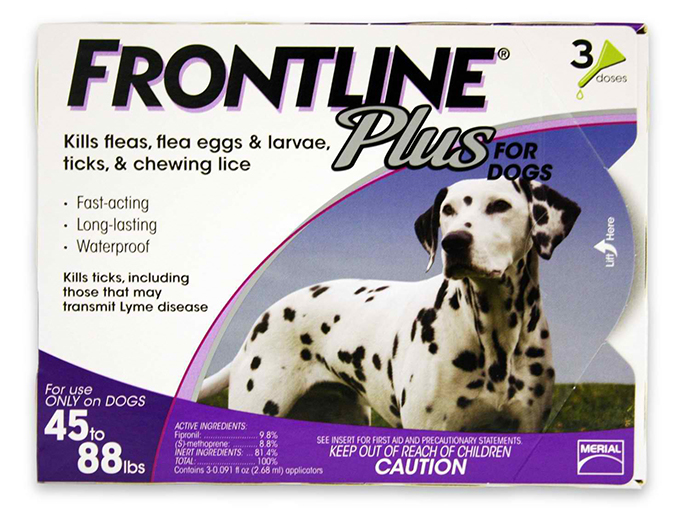
Can Humans Get Fleas from Dogs?
Looking into the sunlight, you see specks of dust flying off your dog. You part your dog’s fur and sure enough, fleas are jumping off your pet onto your arm. You immediately pose the question, “Can humans get fleas from dogs?” The answer is a definite yes – but there are a few things you should know before you start panicking.
Does your dog primarily live outside? Do you not only pet, but often hug your furry friend? Do you live in a warm and humid climate? Is your dog running around without insect and tick protection? If you answered, “yes” to these questions, you definitely could get bugs from your dog.

Poor Online Information
An online search related to whether fleas transfer from dogs to humans can give you inaccurate facts.
Several online sources claim that the fleas jumping off canines are dog bugs and that you can only be bitten by human fleas. Such comments are simply false. Any insect can bite you.
If you want to know the real facts about getting rid of fleas on your pets and in your homes, go here.
And, what most people do not know is that flea foggers do work, read more about it here: atticpestauthority.com/flea-foggers-work
Several Flea Types to Know About
According to the Purdue University Extension Service, about 2,500 varieties of ticks exist worldwide, with roughly 325 flea species in the United States. Of these, the main biting culprit is the cat bugs, with the scientific name of Ctenocephalides felis. Dogs host cat fleas.
The dog flea, or Ctenocephalides canis, also exists, but it’s much more prevalent in Europe, not in the U.S. According to the Centers for Disease Control and Prevention, CDC, both dog and cat fleas bite humans. The human tick, Pulex irritans, is carried primarily by pigs.
The Illinois Department of Public Health flea website states that dog and cat insects are also carried by wild animals, such as raccoons and opossums.
The northern rat bugs, Nosopsyllus fasciitis, and Oriental rat flea, Xenopsylla cheopis, pass the plague and typhus to humans.
In the 14th century, fleas carried bacteria that caused the Black Plague, resulting in the deaths of 25 percent of the entire European human population. Fleas still infect humans with the plague. The CDC says that New Mexico and Arizona are where plague cases are found the most.
Dog Fleas Are NOT Picky About their Hosts
The notion that bugs select their target is nonsense. Insects don’t care what type of animal they land on. They aren’t flying around viewing and selecting their victims.
In fact, a flea cannot fly. Instead, it jumps by springing off its large hind legs.
This tiny insect, which is one-sixteenth to one-eighth of an inch long, can jump as high as eight inches and as long as 16 inches. The Companion Animal Parasite Council (CAPC) website explains that fleas start feeding on any host as soon as they land on the host, which might be you.
According to the Utah State University Extension Service, fleas bite humans when their own source is gone. For instance, fleas infest indoor furniture from an outdoor dog. Flea larvae develop. You sit down on your sofa. The insect sense your warm body and bite you to get your blood.
Your legs and ankles are the most common places where insects bite. Ticks also bite on waists, armpits, and at elbows and knees. A bug bite makes a small red spot. You’ll often see two or three bug bites in a group. People who are allergic to insect bites notice inflamed skin or a rash.
Helping Your Dogs and Pets (with Fleas)
We are more fortunate than 14th century Europeans because modern flea insecticides are efficient and safe at killing insects.
The two most common choices are Frontline® Plus, made by Merial, and Advantage® II, a product of Bayer. These are applied to dogs, not to humans.
Caution must be used when purchasing inexpensive flea prevention insecticides made for pets containing the chemicals permethrin, pyrethroids, or pyrethrins. These drugs are unsafe for cats and can actually kill felines. If a cat is one of your pets, stick with Frontline® or Advantage®.
Stopping these Bugs from within Your Home
Fleas breed quickly and with explosive results. In optimum conditions, insects can go from eggs to adults in as little as seven days. A tick can lay up to 40 eggs a day or 2,000 eggs in a single lifetime. In just a few days, a couple of insects might turn your house into a bug infestation.
Simple tricks are possible in locating and trapping pests as this. One is to place white socks over your shoes and walk through a room. Fleas show up on the white socks. Another is to put soapy water in a shallow pan and shine a gooseneck lamp into the water. Ticks jump to the light and die in the water.
Besides using insect products on your dog, you can stop ticks by destroying or laundering pet bedding. Frequent vacuuming with a beater-type vacuum eliminates adult, larvae, and pupae stages of fleas. Used vacuum bags must be sealed in plastic and thrown away in the outdoor trash.
Serious bug infestations might require the services of a professional flea pest removal service. If their chemicals concern you, consider employing your natural pest removal techniques. A more holistic approach is demonstrated In the following YouTube video.
THE BOTTOM LINE
Can you get fleas from your dog? Yes, and they will bite you as quickly as they bite your dog. Prevention is the best attack to flea problems.
To stop fleas, do the following:
- Use a flea prevention pet insecticide, such as Frontline® Plus, or Advantage® II.
- Wash or destroy pet bedding.
- Vacuum rugs and furniture regularly.
- Use diligence and persistence to kill all fleas and their babies.
For more pest removal information and how to identify the sound of a pest, visit the attic pest authority homepage.


